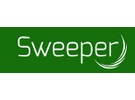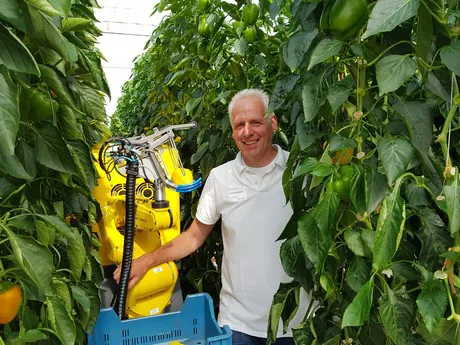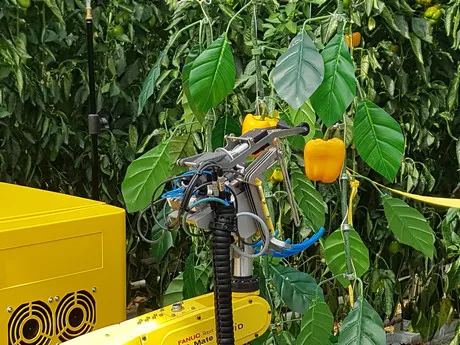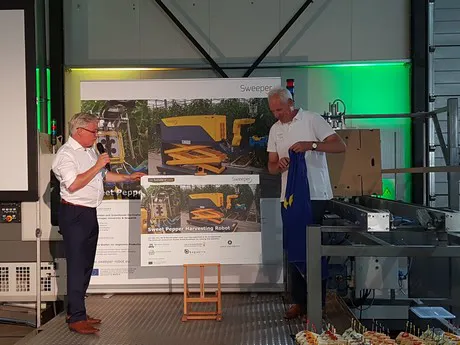A yellow monster runs on the pipe rails between the yellow bell peppers. There is a mechanical sound and, then, flashes of light. Not much later, the grabbing arm reaches toward the detected ripe fruit. A sawing sound follows. The bell pepper drops into the grabbing hand's long metallic fingers. It eventually lands in the plucked fruit collection container. After no more than 30 seconds, the task has been completed, and the robot begins picking the next bell pepper. All this, under the watchful eye of about 50 people. These people watch, mesmerised, as the Sweeper harvesting robot is demonstrated, live, for the first time. The demonstration took place at the De Tuindershoek Nursery in the Netherlands, on Wednesday, 4 July.
Bell pepper farmer, André Kaashoek, with the Sweeper that was tested at his company with a real commercial crop.
Curious? Watch the clip of the demonstration below.
Images thanks to the organisers' cameraman.
Years of research preceded the harvesting robot's development. This robot must offer a solution to growers, and soon. Workers are scarce, and labour costs are ever-increasing. The robot is also responding to the increasing demand for a hygienic product.
Deep learning
It is not yet at this point, despite the considerable steps that have been taken. The robot is being taught how to pick these bell peppers at an accelerated pace. This is being done via deep learning. Here, the robot can practice picking bell peppers in visualisations. These simulated images have been compiled using collected data. This is difficult enough. Bell peppers plants have a lot of leaves and grow in unpredictable directions. This makes it challenging for the robot to find, and correctly cut loose, the ripe fruits.
The Sweeper in action in the testing grounds where the first steps were taken in the development of this robot.
The Sweeper is four times faster than its predecessor from previous
CROPS research. The harvesting robot can pick a bell pepper in an average of 24 seconds. Under laboratory conditions, a time of only 15 seconds was recorded. The robot is deliberately being adapted slowly. This is for safety reasons. So, its speed still leaves a lot to be desired. The motion of the placing the picked fruit into the collection tray affixed to the robot takes the most time. They can, however, easily be speeded up, say the developers.
Harvesting scores
This harvesting robot must soon replace bell pepper pickers. However, according to the developers, it is unrealistic to expect the machine to achieve a 100% harvesting score. A 62% harvesting score was reached under conditioned circumstances. These are preliminary test results done in the run-up to the demonstration. During the test, only fruit growing from the stem was considered. In a commercial greenhouse, the robot scored 31% when picking fruit from the stem. When the fruit growing between the stalks was taken into account, the Sweeper scored even less. It harvested 49% of the crop under ideal conditions versus 20% of a commercial cultivation.
Project coordinator, Jos Balendonck, awards a plaque to André Kaashoek as thanks for his contribution to making the live demonstration possible.
The Sweeper project is financially backed by the European Union's Horizon 2020 programme. This fund runs out in November 2018. From then on, it is up to the concerned parties to give form to the commercial implementation of this harvesting robot. Initially, project partner, Bogaerts Greenhouse Logistics, will be looked to for this. Others - the universities of Wageningen, Ben-Gurion, and Umeå, the Research Station for Vegetable Cultivation, and the De Tuindershoek Nursery - will remain involved. It is expected that, at the very least, another three years is needed before Sweepers will be driving around in commercial greenhouses for real. Until then, farmers will have to make do with videos. For their part, breeders can think about which varieties of bell peppers are most suited to being harvested robotically.
For more information:
Sweeper
Jos Balendonck, project coordinator
jos.balendonck@wur.nl








